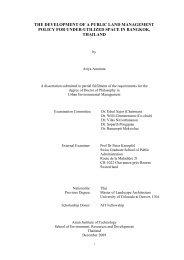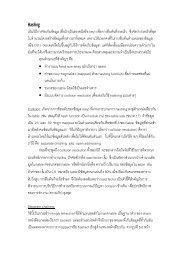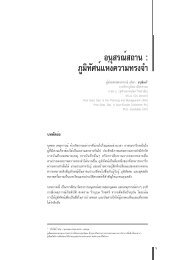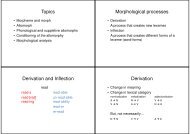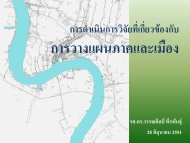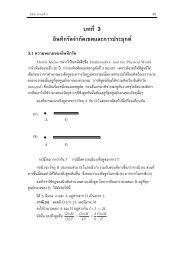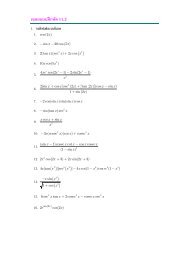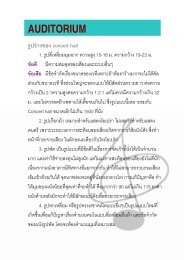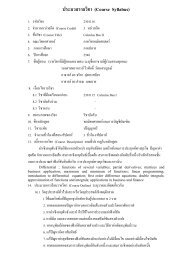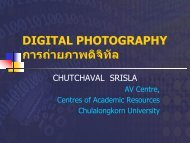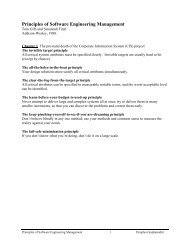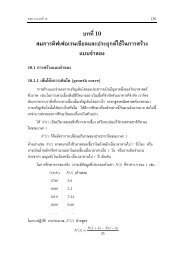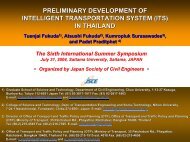A Reflection of English Teaching - Pioneer.chula.ac.th
A Reflection of English Teaching - Pioneer.chula.ac.th
A Reflection of English Teaching - Pioneer.chula.ac.th
You also want an ePaper? Increase the reach of your titles
YUMPU automatically turns print PDFs into web optimized ePapers that Google loves.
A <strong>Reflection</strong> <strong>of</strong> <strong>English</strong> <strong>Te<strong>ac</strong>hing</strong><br />
Kanchana Prapphal<br />
Chulalongkorn University<br />
Abstr<strong>ac</strong>t<br />
From <strong>th</strong>e Grammar-Translation Me<strong>th</strong>od, <strong>th</strong>e Structural Appro<strong>ac</strong>h to <strong>th</strong>e<br />
Communicative Appro<strong>ac</strong>h, we have gained insights into how to assist our students to<br />
<strong>ac</strong>quire and use <strong>th</strong>e target language. It might be concluded from <strong>th</strong>ese appro<strong>ac</strong>hes <strong>th</strong>at<br />
"There is no intellectual grow<strong>th</strong> wi<strong>th</strong>out some reconstruction, some reworking"<br />
(Dewey 1938:64).<br />
Introduction<br />
From <strong>th</strong>e experiences <strong>of</strong> te<strong>ac</strong>hing <strong>English</strong> to students over decades, language<br />
te<strong>ac</strong>hers have tried several appro<strong>ac</strong>hes, me<strong>th</strong>ods, and techniques and we have learned<br />
from <strong>th</strong>eir streng<strong>th</strong>s and weaknesses. From <strong>th</strong>e Grammar-Translation Me<strong>th</strong>od, <strong>th</strong>e<br />
Structural Appro<strong>ac</strong>h, and <strong>th</strong>e Communicative Appro<strong>ac</strong>h, we have gained insights how<br />
to assist our students to <strong>ac</strong>quire and use <strong>th</strong>e target language. The long journey <strong>of</strong><br />
language te<strong>ac</strong>hing and learning seems to appro<strong>ac</strong>h its destination. We tend to agree<br />
<strong>th</strong>at Communicative Language <strong>Te<strong>ac</strong>hing</strong> may help our students to be able to use <strong>th</strong>e<br />
target language for communicative purposes. The empirical evidences from<br />
researchers like B<strong>ac</strong>hman and Palmer (1981) support <strong>th</strong>is claim. To be able to use a<br />
language one needs <strong>th</strong>e knowledge and skills <strong>of</strong> “language use” and “language usage”<br />
(Hymes, 1972, Widdowson 1978, Canale and Swain 1980).<br />
What are some skills and abilities <strong>th</strong>at language te<strong>ac</strong>hers need to have<br />
Cambridge ESOL for te<strong>ac</strong>hers <strong>of</strong> <strong>English</strong> to speakers <strong>of</strong> o<strong>th</strong>er languages has<br />
developed “The <strong>Te<strong>ac</strong>hing</strong> Knowledge Test (TKT)." Following are some skills and<br />
knowledge <strong>th</strong>ey <strong>th</strong>ink are important for <strong>English</strong> te<strong>ac</strong>hers:<br />
1
-Language and <strong>th</strong>e b<strong>ac</strong>kground to te<strong>ac</strong>hing and learning<br />
-Lesson planning and use <strong>of</strong> resources for language te<strong>ac</strong>hing<br />
-Managing <strong>th</strong>e te<strong>ac</strong>hing and learning process.<br />
(http://www.Cambridge ESOL. Org)<br />
The test aims to assess <strong>th</strong>e te<strong>ac</strong>hers’ abilities in understanding concepts and terms<br />
about te<strong>ac</strong>hing and learning. Also, <strong>th</strong>e te<strong>ac</strong>hers need to be familiar wi<strong>th</strong> current<br />
<strong>th</strong>eories, appro<strong>ac</strong>hes and <strong>ac</strong>tivities related to <strong>English</strong> language te<strong>ac</strong>hing. They should<br />
be able to use <strong>th</strong>e <strong>ac</strong>tivities and assess <strong>th</strong>eir usefulness in <strong>th</strong>eir own classrooms. In<br />
addition, <strong>th</strong>ey should be familiar wi<strong>th</strong> some <strong>of</strong> <strong>th</strong>e resources available and keep up wi<strong>th</strong><br />
current trends for pr<strong>of</strong>essional development.<br />
What are <strong>th</strong>e roles <strong>of</strong> language te<strong>ac</strong>hers<br />
The idea <strong>of</strong> “focus on <strong>th</strong>e learner” suggested by Richards and Oller (1975)<br />
greatly changed <strong>th</strong>e roles <strong>of</strong> language te<strong>ac</strong>hers in <strong>th</strong>eir classrooms. The te<strong>ac</strong>her can no<br />
longer be only a lecturer in a language class. We have to take o<strong>th</strong>er roles like materials<br />
adaptors, f<strong>ac</strong>ilitators, consultants, and evaluators. In cooperative learning, <strong>th</strong>e te<strong>ac</strong>her<br />
must know <strong>th</strong>e management techniques. He or she has to understand five principles<br />
underlying learner contribution in an external syllabus: 1) learner commitment, 2)<br />
learners as materials writers and collaborators, 3) learners as problem solvers, 4)<br />
learners as knowers, and 5) learners as evaluators and assessors (Clarke 1989). In brief,<br />
we have to pay more attention to our students and get <strong>th</strong>em involved in <strong>th</strong>e te<strong>ac</strong>hing<br />
and learning process.<br />
What should language te<strong>ac</strong>hers do in <strong>th</strong>e era <strong>of</strong> globalization<br />
The introduction <strong>of</strong> distance education via Inter-and Intranet Pedagogy also<br />
drastically changes <strong>th</strong>e roles <strong>of</strong> language te<strong>ac</strong>hers. We have to equip ourselves wi<strong>th</strong><br />
new types <strong>of</strong> syllabus, materials, tasks and <strong>ac</strong>tivities, and assessment and evaluation.<br />
2
It requires <strong>th</strong>e training <strong>of</strong> net te<strong>ac</strong>hers and <strong>th</strong>e readiness <strong>of</strong> <strong>th</strong>e students. Materials for<br />
<strong>th</strong>e “global classroom” are unlike <strong>th</strong>e traditional textbooks. Tasks and <strong>ac</strong>tivities for <strong>th</strong>e<br />
net pedagogy require prior preparation and planning to ensure <strong>th</strong>at <strong>th</strong>e objectives <strong>of</strong> <strong>th</strong>e<br />
lessons will be <strong>ac</strong>complished. To assess student’ performance, means <strong>of</strong> testing and<br />
evaluation need to correspond wi<strong>th</strong> <strong>th</strong>e nature <strong>of</strong> te<strong>ac</strong>hing. In addition, <strong>th</strong>e attitude and<br />
<strong>th</strong>e receptiveness <strong>of</strong> <strong>th</strong>e te<strong>ac</strong>hers and students have to be changed.<br />
To cope in <strong>th</strong>e era <strong>of</strong> globalization, students can no longer be “spoon-fed.” To<br />
help <strong>th</strong>em <strong>ac</strong>hieve <strong>th</strong>eir own objectives and pursue <strong>th</strong>eir life-long education, te<strong>ac</strong>hers<br />
<strong>th</strong>emselves have to change <strong>th</strong>eir roles. In <strong>th</strong>e “global classroom” <strong>th</strong>e te<strong>ac</strong>her must be<br />
<strong>th</strong>e f<strong>ac</strong>ilitator who provides comprehensible input and gives feedb<strong>ac</strong>k to <strong>th</strong>e students’<br />
output. The task requires a lot <strong>of</strong> responsibility, skills, knowledge and devotion<br />
because net te<strong>ac</strong>hers have to learn about <strong>th</strong>eir students’ computer b<strong>ac</strong>kground,<br />
language abilities as well as <strong>th</strong>eir needs and interests. They have to select appropriate<br />
language tasks to match <strong>th</strong>e students’ linguistic b<strong>ac</strong>kgrounds, cognitive and <strong>ac</strong>ademic<br />
abilities. Also, te<strong>ac</strong>hers have to provide immediate feedb<strong>ac</strong>k and create co-operation<br />
among students.<br />
However, Wagner et al (1996:3) warned us <strong>th</strong>at <strong>th</strong>e computer cannot repl<strong>ac</strong>e <strong>th</strong>e<br />
te<strong>ac</strong>her or motivate students to learn. They said, “And if you want computers to<br />
overcome poor te<strong>ac</strong>hing, overcrowded classrooms or unmotivated students, forget <strong>th</strong>e<br />
whole <strong>th</strong>ing.” In f<strong>ac</strong>t, technology should be viewed as ano<strong>th</strong>er tool for language<br />
te<strong>ac</strong>hers. Whe<strong>th</strong>er it can provide <strong>th</strong>e greatest benefit for enhancing instruction or not<br />
depends on <strong>th</strong>e te<strong>ac</strong>her’s attitude, understanding, dedication, and innovative mind.<br />
Can language te<strong>ac</strong>hers ignore <strong>th</strong>e use <strong>of</strong> IT<br />
In higher education if one <strong>of</strong> our goals in language te<strong>ac</strong>hing is to prepare our<br />
students to be qualified world citizens, <strong>th</strong>e ability to use <strong>English</strong> and <strong>th</strong>e Internet is one<br />
essential quality. This is because our graduates can collaborate and share <strong>th</strong>eir<br />
knowledge, feelings and beliefs wi<strong>th</strong> peers from any corner <strong>of</strong> <strong>th</strong>e world. This issue <strong>of</strong><br />
3
higher education quality was discussed in <strong>th</strong>e World Conference on Higher Education<br />
organized by UNESCO.<br />
“Quality also requires <strong>th</strong>at higher education should be char<strong>ac</strong>terized by its<br />
international dimension: exchange <strong>of</strong> knowledge, inter<strong>ac</strong>tive networking, mobility <strong>of</strong><br />
te<strong>ac</strong>hers and students, and international research projects.”<br />
(Wang and Kim, 2000:1)<br />
In terms <strong>of</strong> assessment and evaluation, new me<strong>th</strong>ods <strong>of</strong> assessing competencies<br />
<strong>of</strong> language use <strong>of</strong> learners have to be included in <strong>th</strong>e syllabus. Bo<strong>th</strong> process and<br />
product assessment and evaluation need to be considered. To reinforce inter<strong>ac</strong>tive<br />
networking, electronic portfolios, teleconferencing, on-line self tests, email writing<br />
tasks, etc. should be incorporated in <strong>th</strong>e te<strong>ac</strong>hing and learning process.<br />
What about <strong>th</strong>e expectations <strong>of</strong> stakeholders<br />
A Chapter in <strong>th</strong>e Educational Reform Act stated <strong>th</strong>at Thai learners should have<br />
global liter<strong>ac</strong>y. That is <strong>th</strong>ey must know <strong>English</strong>, be able to use <strong>th</strong>e Internet, and<br />
understand cultures <strong>of</strong> o<strong>th</strong>er countries to be qualified as world citizens. Wongboonsin<br />
et al. (2003) report <strong>th</strong>e desirable skills, competencies, and qualifications suggested by<br />
stakeholders, <strong>ac</strong>ademicians, and specialists in human resource development:<br />
“a. Skills: Thai learners should be equipped wi<strong>th</strong> conceptual skills, operating<br />
skills, technical skills, management skills, human skills, and communication skills.<br />
b. Competencies: They should have <strong>English</strong> pr<strong>of</strong>iciency, computer liter<strong>ac</strong>y,<br />
analytical ability, innovation, and critical <strong>th</strong>inking.<br />
c. Qualifications: They must meet international standards, adopt <strong>th</strong>e attitudes<br />
<strong>of</strong> life-long learning, and have positive attitudes towards learning and working. In<br />
addition, <strong>th</strong>ey should be able to work in a team.”<br />
4
Therefore, to help our students, especially at <strong>th</strong>e higher level, to become equipped wi<strong>th</strong><br />
<strong>th</strong>e skills <strong>th</strong>at bo<strong>th</strong> <strong>ac</strong>ademic and business sectors require, <strong>English</strong> skills, computer<br />
skills and knowledge <strong>of</strong> cultures need to be integrated into language courses.<br />
What should we do next<br />
We need to adjust ourselves to cope wi<strong>th</strong> <strong>th</strong>e fast changing world. To meet <strong>th</strong>e<br />
international standard, in designing a language course one must consider <strong>th</strong>e local<br />
needs as well as regional and global needs. The information should be drawn from<br />
te<strong>ac</strong>hers, administrators, students, stakeholders and o<strong>th</strong>er parties concerned. For<br />
example, Short (2003) proposes <strong>th</strong>e following ESL goals for Pre-K-12 students.<br />
Goal 1: To use <strong>English</strong> to communicate in social settings.<br />
Goal 2: To use <strong>English</strong> to <strong>ac</strong>hieve <strong>ac</strong>ademically in all content areas.<br />
Goal 3: To use <strong>English</strong> in socially and culturally appropriate ways.<br />
In terms <strong>of</strong> materials development, <strong>th</strong>e materials should be prepared based on <strong>th</strong>e<br />
goals and objectives obtained from needs assessment. Bo<strong>th</strong> te<strong>ac</strong>hing materials and<br />
learning materials should be employed. Also, different types <strong>of</strong> materials such as texts,<br />
newspapers, tapes, CD-Rom, Internet, etc. should be used where appropriate to<br />
encourage bo<strong>th</strong> learning and <strong>ac</strong>quisition in <strong>th</strong>e classroom and outside <strong>th</strong>e classroom.<br />
Me<strong>th</strong>ods <strong>of</strong> te<strong>ac</strong>hing have to be adapted. Te<strong>ac</strong>hers can supplement <strong>th</strong>eir te<strong>ac</strong>hing by<br />
using IT tasks such as CALL <strong>ac</strong>tivities, E-mail writing tasks, web-based projects,<br />
electronic student portfolios, etc. Choosing appropriate tasks for students, te<strong>ac</strong>hers can<br />
enhance <strong>th</strong>eir students’ general pr<strong>of</strong>iciency as well as <strong>ac</strong>hieve <strong>th</strong>e desirable goals and<br />
objectives. However, <strong>th</strong>ey should bear in mind <strong>th</strong>at<br />
1. Technology cannot substitute for a good language te<strong>ac</strong>her but it can<br />
supplement and f<strong>ac</strong>ilitate our te<strong>ac</strong>hing.<br />
2. Our responsibility is to help our students to communicate and realize <strong>th</strong>at<br />
<strong>th</strong>ey are part <strong>of</strong> <strong>th</strong>e “global village.”<br />
5
In addition, <strong>th</strong>e roles <strong>of</strong> <strong>th</strong>e te<strong>ac</strong>her and learner will change <strong>ac</strong>cording to <strong>th</strong>e new<br />
te<strong>ac</strong>hing paradigm. The te<strong>ac</strong>hers have to <strong>ac</strong>t as te<strong>ac</strong>hers, f<strong>ac</strong>ilitators, mentors, as well<br />
as assessors and evaluators, whereas <strong>th</strong>e students have to be learners, collaborators,<br />
problem solvers, <strong>th</strong>inkers, as well as assessors and evaluators. Different me<strong>th</strong>ods<br />
using IT such as Intranet pedagogy and Internet pedagogy like web-based te<strong>ac</strong>hing,<br />
distance education and virtual classrooms may be adopted when <strong>th</strong>ere is a l<strong>ac</strong>k <strong>of</strong><br />
language te<strong>ac</strong>hers. (See Prapphal 1997, 1998, and 2001 for more details.)<br />
To assist our colleagues to keep up wi<strong>th</strong> <strong>th</strong>e current trends in language te<strong>ac</strong>hing<br />
and learning, in-service training in <strong>English</strong> language te<strong>ac</strong>hing should be conducted.<br />
These components must be included in <strong>th</strong>e syllabus:<br />
1. Language Development<br />
2. Current trends in language te<strong>ac</strong>hing and learning<br />
3. Effective ways <strong>of</strong> using te<strong>ac</strong>hing and learning materials<br />
4. Me<strong>th</strong>odology in language te<strong>ac</strong>hing<br />
5. Assessment and evaluation<br />
To enhance our pr<strong>of</strong>ession and help our students to meet <strong>th</strong>e<br />
expectations <strong>of</strong> <strong>th</strong>e society and <strong>th</strong>e world, we should adopt <strong>th</strong>e attitude <strong>th</strong>at “There is<br />
no intellectual grow<strong>th</strong> wi<strong>th</strong>out some reconstruction, some reworking” (Dewey<br />
1938:64). Reflecting our weaknesses and streng<strong>th</strong>s and sharing <strong>th</strong>em wi<strong>th</strong> peers in<br />
ELT can help us solve problems in <strong>English</strong> te<strong>ac</strong>hing. Carrying out <strong>ac</strong>tion research is<br />
ano<strong>th</strong>er possible way to address specific issues <strong>of</strong> classroom pr<strong>ac</strong>tice on a small and<br />
local scale. Last but not least, being positive in our own career and adopting <strong>th</strong>e<br />
attitude <strong>of</strong> life-long learning may assist us to re<strong>ac</strong>h our common goals.<br />
6
References<br />
B<strong>ac</strong>hman, L.F. and Palmer, A.S. 1981. A multitrait-multime<strong>th</strong>od<br />
investigation into <strong>th</strong>e construct validity <strong>of</strong> six tests <strong>of</strong> speaking and<br />
reading. In A.S. Palmer, P.J.M. Groot, and G.A. Trosper (Eds.), The<br />
Construct Validation <strong>of</strong> Tests <strong>of</strong> Communicative Competence. Washington,<br />
D.C.: TESOL.<br />
Canale, M. and Swain, M. 1980. Theoretical bases <strong>of</strong> communicative appro<strong>ac</strong>hes to<br />
second-language te<strong>ac</strong>hing and testing. Applied Linguistics, 1(1), 1-47.<br />
Clarke, D.F. 1989. Materials adaptation: Why leave it all to <strong>th</strong>e te<strong>ac</strong>hers ELT<br />
Journal, 43(2), 133-141.<br />
Dewey, J. 1938. Art as Experience. New York: Minton, Balch.<br />
Friere, P. 1975. Pedagogy <strong>of</strong> <strong>th</strong>e oppressed. In M.Golby, J.Greenwald and R. West<br />
(Eds.), Curriculum Design (pp.138-149). London:Croom Helm.<br />
Hymes, D.H. 1972. On communicative competence. In J.B. Pride and J. Holmes<br />
(Eds.), Sociolinguistics. Harmondswor<strong>th</strong>: Penguin.<br />
Prapphal, K. 1997. Education technology for TEFL. PASAA, 27, 121-127.<br />
Prapphal, K. 1998. Self-directed learning <strong>th</strong>rough <strong>th</strong>e Internet and Intranet pedagogy: a<br />
choice for language te<strong>ac</strong>hers. PASAA, 28, 62-82.<br />
Prapphal, K. 2001. Globalization <strong>th</strong>rough distance education via Inter- and Intranet<br />
pedagogy. PASAA, 31, 75-81.<br />
Richards, J.C. and Oller, J.W. (Eds.), 1975 . Focus on <strong>th</strong>e Learner. New York:<br />
Newbury House Publishers.<br />
Wagner, B., Gregory, S., Bierck, R., Daniel, M. and Sapers, J. 1996. Where<br />
computers do work. U.S. News and World Report, Dec. 2, 82-93.<br />
Wang. Y. and Kim, C-H. (November 2000). Quality assurance, credit transfer and<br />
mutual recognition in higher education—Role on Quality Assurance in Higher<br />
Education: Standard, Mechanisms and Mutual Recognition. Bangkok, Thailand.<br />
7
Widdowson, H.G. 1978. <strong>Te<strong>ac</strong>hing</strong> Language as Communication. London: Oxford<br />
University Press.<br />
Wongboonsin, K., Khunawat, M., Prapphal, K., Hongladarom, S. Surasiangsung, S.<br />
Chowpreecha, S., Bunjerdpong, D. and Opanon-Amata, S. 2003. A study on <strong>th</strong>e<br />
future <strong>of</strong> Thai workforce. National Research Council <strong>of</strong> Thailand.<br />
http://www.Cambridge ESOL.org.<br />
http://www.cal.org/ericcll/digest/0013ESLstandards.html.<br />
Published in MANUSYA: Journal <strong>of</strong> Humanities. Special Issue No. 7 (2004)<br />
Foreign Language <strong>Te<strong>ac</strong>hing</strong> in Thailand, 1-5.<br />
8




